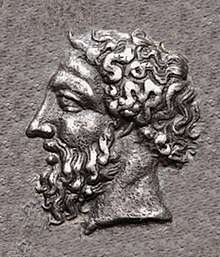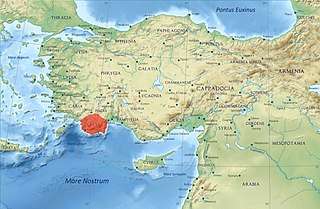Mithrapata
Mithrapata (circa 390-370 BC) was dynast of Lycia in the early 4th century BC, at a time when this part of Anatolia was subject to the Persian, or Achaemenid, Empire.
Mithrapata | |
|---|---|
 Portrait of Mithrapata, from his coinage. | |
| Allegiance | Achaemenid Empire |
| Years of service | fl. 390 – 370 BC |
| Rank | Dynast of Lycia |

Present-day knowledge of Lycia in the period of classical antiquity comes mostly from archaeology, in which this region is unusually rich. Believed to have been based at Antiphellus, Mithrapata is known to have competed for power with another man named Arttumpara.[1]
The name of Mithrapata, which is of Persian origin, is known from Lycian coins and also from inscriptions.[2] During the fifth and fourth centuries B.C., the Lycian nobility was using Persian names,[3] so Mithrapata may have been one of them. However, it has also been suggested that he may have been a Persian sent to rule Lycia by Artaxerxes II.[4]
Coinage
Together with Pericles, Mithrapata was the last ruler of Lycia to issue coins. After about 360 BC, the region of Lycia was taken over by the Carian dynast Mausolus.[5]
As with Pericles, the portrait of Mithrapata seen on his coins does not show him wearing the head-dress of an Achaemenid satrap, which suggests a degree of independence from the Achaemenid Empire. His name appears in the Greek alphabet as "Methrapata".[6]
 Coin of Mithrapata, c. 390-370 BC
Coin of Mithrapata, c. 390-370 BC Coin of Mithrapata, c. 390-370 BC
Coin of Mithrapata, c. 390-370 BC
Notes
- D. T. Potts, A Companion to the Archaeology of the Ancient Near East (2012), p. 912: "...c. 380–370 BC, two western Lycian dynasts named Arttumpara and Mithrapata claimed power simultaneously."
- Lisbeth S. Fried, The Priest and the Great King: Temple-palace Relations in the Persian Empire (Eisenbrauns, 2004), p. 150
- Muhammad A. Dandamaev, Vladimir G. Lukonin, The Culture and Social Institutions of Ancient Iran (2004), p. 300
- Trevor Bryce, Jan Zahle, The Lycians: The Lycians in literary and epigraphic sources (1986), p. 162
- CNG: DYNASTS of LYCIA. Mithrapata. Circa 390-370 BC. AR Stater (23mm, 9.73 g, 5h).
- CNG: DYNASTS of LYCIA. Mithrapata. Circa 390-370 BC. AR Stater (23mm, 9.73 g, 5h).